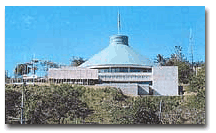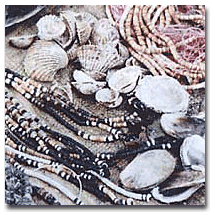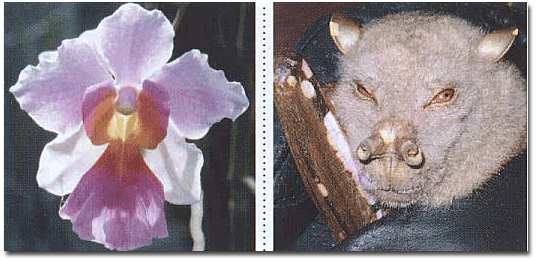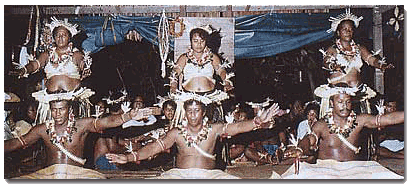
geography politics economy people nature history culture religion
Geography
Centred around longitude 160 degrees east and latitude 9 degrees south
of the equator, Solomon Islands comprises 992 islands, of which 347 are
inhabited. These stretch 1448 kilometres (900 miles) in a south-easterly
direction from the Shortland Islands, on the border with Papua New Guinea,
to the Santa Cruz Islands, which borders with Vanuatu. The archipelago
covers an area of 461,000 sq km (249,000 sq nautical miles), of which
28,446 sq km (10,938 sq miles) is landmass. The six biggest islands are
Choiseul, New Georgia, Santa Ysabel, Guadalcanal, Malaita and Makira.
On the atlas, Solomon Islands lies northeast of Australia and southwest of Hawaii. Deeply forested mountainous islands add a towering contrast to lowlying coral atolls, right down to the tiny artificial islands built of coral and soil common on Malaita's northern coast.
Solomon Islands follows the Westminster system of democracy with the
British monarch retained as head of state, represented in the country
by a Governor General.
The Prime Minister is head of government who leads a group of cabinet
ministers.
The country's 50-seat parliament, perched on a ridge overlooking Honiara,
sits several times a year.

The prime minister, elected by Parliament, chooses the other members of the cabinet. Each ministry is headed by a cabinet member, who is assisted by a permanent secretary, a career public servant, who directs the staff of the ministry.
For local government, the country is divided into
10 administrative areas, of which nine are provinces, administered by
elected provincial assemblies, and the 10th is the city of Honiara, administered
a city council, headed by a mayor.
Land ownership is reserved for Solomon Islanders. At the time of independence,
citizenship was granted to all persons whose parents are or were both
British protected persons and members of a group, tribe, or line indigenous
to the Solomon Islands.
The law provides that resident expatriates, such as the Chinese and Kiribati,
may obtain citizenship through naturalisation. Land generally is still
held on a family or village basis and may be handed down from mother or
father according to local custom. The islanders are reluctant to provide
land for non-traditional economic undertakings, and this has resulted
in continual disputes over land ownership.
No military forces are maintained by the Solomon Islands, although the
police force of nearly 500 includes a border protection element. The police
also have responsibility for fire service, disaster relief, and maritime
surveillance. The police force is headed by a commissioner, appointed
by the Governor General and responsible to the prime minister.
Agriculture, forestry and fishing form the backbone of the Solomons’
economy, contributing 63 percent of the country's Gross Domestic Product
in 2004. While anti- exploitation legislation on logging is expected to
slow down growth in forestry, economists are still projecting positive
growths of 3 to 6 percent from 2005 to 2007. That growth will be surpassed
if the closed Gold Ridge gold mine on Guadalcanal re-opens, as well as
revived palm oil production in Guadalcanal and Malaita. Palm oil, copra,
timber and fish products are the main sources of foreign exchange, foreign
reserves topping US$73.2 million by December 2004 - enough to cover 7
months of import. Major trading partners are Australia, Malaysia, Japan,
South Korea and Taiwan.

Infrastructure rehabilitation, externally funded, is generating growth
in construction, whilst the services sector is also reporting marginal
growths.
An Asian Development Bank assessment attributes this to improved law
and order situation, under the Australian Government-sponsored Regional
Assistance Mission for the Solomon Islands.
Inflation is now at a manageable level of 6.5 percent (2004) due to the
flow of supply of fresh fruit and vegetables to the Honiara market and
stability in the exchange rate.
For 2005 and beyond, inflation is expected to hover around 5 percent,
provided monetary policies control inflationary pressures and the exchange
rate continues to remain stable.
As part of the Melanesian group of islands that also includes Papua New
Guinea, Vanuatu, New Caledonia and Fiji, Solomon Islands was first settled
by hunters and gatherers from Southeast Asia. Seafarers followed later.
Through the tracing of a distinct type of pottery called Lapita, archaeologists
say the original settlers of Polynesia in eastern Pacific trace their
origins back to Melanesia, to the Solomon Islands actually.
Today, between 70 to 80 percent of the population lives a subsistence form of life in their small villages, settlements and islands away from the main urban centres.


The main islands of the Solomons are volcanic in origin, covered with
dense tropical forest with fast flowing rivers and streams. They are home
to many endemic flora and fauna species which includes the common cardinal
1orry.
Current estimates put a total of 4500 plant species and 173 species of birds including the famous Megapode bird which nests in the thermal sand of some islands in Central and Western provinces. In the World Heritage Listed Rennell Island alone, ten plants and 4 species and 9 subspecies of birds have been identified as endemic. Also endemic is the saltwater sea snake known as the krait.
History
Archaeological and linguistic evidence shows that Solomon Islands was
settled between 4000 - 5000 Years ago by people from Southeast Asia. From
here, a group continued the east and south migration, settling in what
is now known as Vanuatu, New Caledonia, Fiji and the Polynesian islands
of Tonga and Samoa. It was not one way though, as archaeologists point
to a return migration of mainly Polynesians sometime later. Their descendants
now live in atolls that border Solomon Islands northern and eastern boundaries.
It was not until the 16th century that the European world came to learn
of Solomon Islands. Spanish explorer Alvaro de Mendana made the first
contact in 1568. When he discovered alluvial gold on Guadalcanal, he thought
he had found the source of King Solomon’s great wealth and named it the
Isles of Solomon. It was through his influence that many of the islands
in the archipelago bear original Spanish names. After Mendana, others
- mainly Dutch and French explorers - made forays into the group. Then
it became the turn of the Germans and British.
The islands of New Georgia, Guadalcanal, Makira and Malaita became a
British protectorate in 1893 with Tulagi proclaimed the protectorate capital
in 1896. The islands of Santa Cruz, Rennell and Bellona were included
between 1898 and 1899. The Shortlands, Choiseul, Santa Ysabel and Ontong
Java were not roped into the protectorate until 1900.
Japanese aggression turned the islands into a theatre of war during World War II. Both the Japanese and A1lied Forces suffered huge losses in land, sea and aerial battles. Over 60 years later, the archipelago is littered with war wrecks and some of the country's infrastructure today, Iike airstrips and roads, owe their existence to the war. Solomon Islands gained independence from Britain on July 7, 1978. Twenty years later in 1998, tribal rivalries erupted into armed hostilities on Guadalcanal, which prompted Australia and its Pacific islands neighbours to launch RAMSI, the Regional Assistance Mission to Solomon Islands, in July 2003. Hostilities have ended and the nation is back on track with an elected government in power.

Communal, clan and family ties remain strong in these islands with the existence of the Wantok system. A key part of the Melanesian culture, Wantok means people from the same language group who are blood relatives and part of the extended family support and assist one another. Kastom, the Pidgin term for custom, refers to traditional beliefs and land ownership. Despite the predominance of devout Christians, traditional practices are still being followed, especially by those living in the interior of the country's larger islands. Off the beaten path, village life remains much as it has been for centuries. While some do welcome strangers, not all do so --- so it is always a good practice to ask local authorities first before venturing to visit these remote and far-flung areas.
About 95% of the population are Christians. The principal religions are Church of Melanesia (Anglican) about 25%; Roman Catholic 190%; South Seas Evangelical 17%; United Church (Methodist) 11%; and Seventh Day Adventist 10%. More recently, new religions have made an impact notably the Baha'i faith, Jehovah's Witness, Assemblies of God and Baptist.